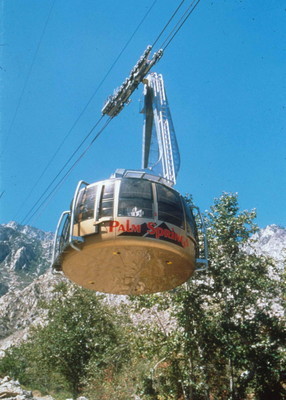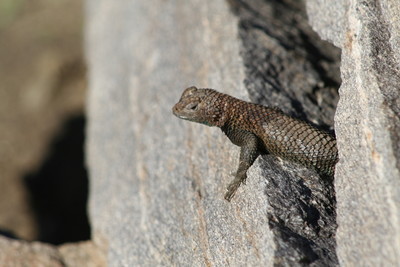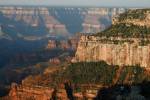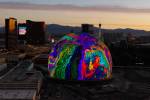Best of Both Worlds
When you think of Palm Springs you usually don't think of feeding hungry giraffes, visiting nature preserves or making a snowman, but that is exactly what we did on a recent three-day visit. So successfully has the city promoted itself as a luxury resort that one forgets how pleasant the natural setting can be during its mild winters, and how agreeably it blends with the man-made amenities.
Within a half hour of arriving in Palm Springs, my daughter, Charlotte, and I were heading straight up a steep ravine, aboard the world's largest rotating tram car. The tram's two-and-one-half mile route gains nearly 6,000 feet in elevation, leaving behind the sea of palm trees in Coachella Valley and discharging its passengers about 10 minutes later atop the heavily alpine forested Mount San Jacinto Mountains.
Over the past 45 years, millions of people have been safely transported up the tramway, but I am sure a large percentage of them felt a moment of panic like I did. The ride is extremely smooth until the tram passes through one of the upper towers. Here it swings so much it felt as if would become unhinged, fall like a dead weight and bounce its way down thousands of feet to the valley floor.
After arriving safely on top we bypassed what most people come for -- lounge-and-restaurant relaxation with far-reaching views. Instead, heading out the back door of the tram's Mountain Station, we found two feet of snow and room to play in it.
Temperatures up here average about 30 degrees cooler than in the valley. When there is enough snow, the 54 miles of summer hiking trails are transformed into a winter playground. Visitors can go tubing or head out the trails on cross country skis or snowshoes. You can rent equipment at the Winter Adventure Center. Or, like us, you can simply play in the snow.
We found dozens of children tubing down small hills. We headed out on foot on the Long Valley Discovery Trail, spending about one hour exploring before Charlotte settled down to make a couple of snow angels and to build a snowman. As we headed back to the walkway, we both got pelted with snowballs by an enthusiastic boy of maybe 5 or 6, who thought hitting us was the funniest thing he had ever seen.
We had a quick lunch, and enjoyed the views before heading back down the tram. Still cold and wet from our mountain outing, we checked into the Pepper Tree Inn, changed into bathing suits and were soon lounging poolside under the desert sun. The Pepper Tree Inn is a Spanish Colonial boutique hotel, elegant in many ways, including the most important: a feeling of coziness and comfort as if we had been staying at a friend's bungalow. Our room had a fireplace and excellent views of the San Jacintos.
Such boutique hotels and historic inns are the most popular lodging choices in Palm Springs. Many have proven ideal hideaways for celebrities, but you don't need to be famous to enjoy such a low-key getaway. Typically, they have fewer than 50 guest rooms; some have fireplaces and personal patios. All have swimming pools and most are within walking distance of historic downtown.
That evening, we took that stroll to eat at Las Casueloas Terraza, which has been recognized as one of the best Hispanic restaurants in the nation. It offers ambiance as well, whether you are sitting in an indoor private booth or dining outdoors listening to a live band. The food can't be beat, but the place is equally well known for its margaritas. Choices are virtually unlimited, as they serve more than 50 different tequilas.
The historic area was packed with people. Year-round on Thursday nights, the historic area of Palm Canyon Drive is shut down to traffic for the Village Fest. Here, you will find live music, food and booths that feature high-end arts and crafts of every type imaginable. We stopped and listened to a few street musicians including one little girl, who I guessed to be around 6 years old, playing bluegrass on a half-sized fiddle. The gathering crowd was delighted.
Our next morning we headed over to the Spa Resort Casino to meet Tim Regalado, our guide from Best of the Best Tours, to go on a three-and-one-half-hour jeep excursion. Our first stop was at one of the Indian Canyons preserves of nature and archaeology, located just a couple of miles out of town. The canyons are the largest palm oases in the world, home to thousands of Washingtonia filifera, the California fan palm.
Palm, Andreas, Murray and Tahquitz Canyons are managed by the Agua Caliente Band of Cahuilla Indians whose ancestors settled Palm Springs. Their reservation contains 32,000 acres, 6,700 of them within the city limits, the rest checker-boarded over nearby lands.
We stopped first at Andreas Canyon, the second largest. Out of the jeep we hit the trail, first stopping at a large flat boulder, where Regalado pointed out 13 depressions worn deep into the rock, the bottom of each rounded like a kitchen bowl.
"These were used as grinding mortars to make flour from many different plants, like the screw bean mesquite," he said, adding that these particular mortars are more than 500 years old.
As we continued up the trail, Regalado spoke about the other indigenous plants and how the Indians used them. Pointing to two different plants, he said, "The Indians used arrow reed to make their arrow shafts and the women made a perfume powder out of this lavender bush." As for food, he said, "One of the best plants in the canyon is the cat's claw acacia, very nutritious and made up of 27 percent protein."
These canyons provided all the basics for the Cahuilla when they lived off the land. More than 200 different plants in the area and an abundance of wild game provided food, medicine, clothing and shelter.
We followed the well-worn trail up the canyon between the palm-lined Andreas Creek on one side and steep, rugged cliffs on the other. While Regalado and I walked slowly up the canyon, Charlotte was busy wandering down the spur trails to water's edge, jumping boulders, enjoying some of the waterfalls close-up and then returning to the trail.
The next canyon south is Murray Canyon, which can be accessed from Andreas by a short and easy hike. Even so, this canyon is more remote and all the more worth visiting, for you might see the endangered peninsula bighorn sheep, mule deer, wild ponies and a variety of birds, including the endangered Bell's vireo, which is known to nest here.
Another note on "wild life." If you decide to visit Murray Canyon, be prepared to see a few naturists, who come for that all-over tan.
After leaving the Indian Canyons, we changed gears completely by heading up into the Old Las Palmas neighborhood for a tour of celebrity homes. We toured past the former homes of Liberace, Marilyn Monroe, Elvis, Jack Benny and Bob Hope. Regalado stopped briefly at Kirk Douglas' house, where he said, "On my first tour ever, in 1998, we were passing by here and found Kurt in his swim trunks washing his Mercedes, and he even happily signed autographs for my group."
Most of the houses in this neighborhood seem modest in size, yet are worth seeing for their architecture alone. The style here is known as mid-century modernism or Palm Springs modern style. The National Trust for Historic Preservation named Palm Springs to its 2006 list of America's Dozen Distinctive Destinations -- an annual honor to unique communities that have been preserved.
Nightlife in Palm Springs is pretty much anything you want it to be, from elegant dining, supper clubs, jazz and theater to more family-friendly activities. Since it was Charlotte's 11th birthday, the dinner choice was hers. After checking out a few menus, to be assured they had something a picky eater might enjoy, she settled on Matchbox Vintage Pizza Bistro. Arriving early in the evening, we were able to snag one of the choicest tables, on a private second-floor patio that overlooked Palm Canyon Drive.
The next morning we checked out of our room and headed to the nearby city of Palm Desert and its wildlife and botanical park, Living Desert. Established in 1970, it encompasses 1,200 acres and celebrates not only the surrounding Mojave desert, but those from other parts of the world. There are more than 400 animals representing close to 150 species, as well as appropriate plants, from 10 different desert ecosystems.
At the entrance, we picked up the day's schedule of events. There was a lot going on, but the Giraffe Chat sparked our interest the most. After talking to one of the docents who told us we might be able to feed them, we were sold. With an hour to spare, we decided to first check out Village WaTuTu.
WaTuTu is a replica northeast African village of mud-walled huts with thatched roofs. On the outskirts of the village you can see leopards, camels, striped hyenas and addax, and within the village itself are restaurants, shops and plenty of activities to maintain interest for children of any age. Charlotte tried playing the African drums, and tested some tribal toys. Then we went over to the petting kraal, where she got to brush the silky coats of a dwarf African goat and a Nubian goat.
By the time we reached the three-acre giraffe compound, a crowd had already gathered on an elevated walkway that serves as the viewing area. From about 20 yards away, we watched three of the four reticulated giraffes eat from a hay basket located high on a pole. The fourth was not tall enough to reach the "table" but seemed perfectly happy to eat what dropped to the ground.
Adult giraffes usually weigh 1,750 to 2,800 pounds, reach heights of 18 feet and can eat as much as 75 pounds of food daily. Here, they get their fill from alfalfa hay and pellets, and a wide variety of produce including apples, bananas, yams, carrots and zucchini.
The three adult giraffes have Swahili names -- Dadisi, Hesaby and Pona which mean respectively, "She brings Joy," "Arithmetic," and "Get Well." Dadisi and Hesaby, both 7 years old, are the parents of the young giraffe named Mutombo, who was born at the park in Sept. 2006. If that name sounds familiar it's because he was named after the Congolese/American professional basketball player who is giraffe-like in stature himself at 7-feet-2.
Once the giraffes realized it was time for their snack, which was thanks to a park docent ringing a small bell, they headed over to where we were. Feeding the giraffes turned out to be easy, yet somewhat intimidating for Charlotte. She fed Mutombo first and then moved onto Dadisi and Heseby, each time holding an alfalfa pellet in her hand and then dropping the pellet on the giraffe's tongue. Wanting more treats though, the giraffes often reached out for it and Charlotte got licked a few times. The experience is endearing but not for everyone; a giraffe tongue can be as long as 18 inches and Charlotte told me it felt like extremely slimy sandpaper.
We ran out of time before we ran out of Palm Springs, which is the mark of an excellent destination. And turning the wheels homeward I thought, this is a very civilized one -- an optimal combination of outdoor adventure and luxurious rest.
GETTING THERE
Location: Palm Springs, Calif., about 280 miles southwest of Las Vegas.
Directions: From Las Vegas, take I-15 south about 214 miles to I-215 south. Drive 13.5 miles and go east on I-10 for 40 miles. Go right onto California Route 111 for about 10 miles to downtown Palm Springs.
Lodging: The Pepper Tree Inn starts at $150 a night, weekdays, 622 N. Palm Canyon Drive, (760) 318-9850, www.peppertreepalmsprings.com. Viceroy Palm Springs, starts at $250 a night, weekdays, 415 S. Belardo Road, (760) 320-4117, www.viceroypalmsprings.com. Also, city tourism site below lists accommodations of all sorts and prices.
Visitor information: Palm Springs Bureau of Tourism, 777 N. Palm Canyon Drive, (800) 347-7746, www.palm-springs.org.
Dining: Las Casuelas Terraza, lunch and dinner, 222 S. Palm Canyon Drive, (760) 325-2794, www.lascasuelas.com. Matchbook Vintage Pizza Bistro, dinner, 155 S. Palm Canyon Drive, (760) 778-6000, www.matchboxpalmsprings.com. Agua Bar and Grill, breakfast, lunch and dinner, 100 N. Indian Canyon Drive at the Spa Resort Hotel, (888) 999-1995, www.sparesortcasino.com.
Palm Springs Aerial Tram: A vertical ascent of 5,873 feet over a 2.5-mile ride. Open daily. Tram cars leave Mondays-Fridays starting at 10 a.m.; Saturdays, Sundays and holidays at 8 a.m. Last car down at 9:45 p.m. Cars leave tram stations at least every half hour. Handicap accessible. The Winter Adventure Center is open through mid-April, snow conditions permitting. (760) 325-1391, www.pstramway.com.
Mount San Jacinto State Park and Wilderness Area: Accessed via the tramway, there are 54 miles of trails and primitive campgrounds. Winter camping, extended cross-country skiing and snowshoeing in wilderness areas is allowed with a free permit, available at the ranger station in Long Valley, below Mountain Station. (909) 659-2607, www.parks.ca.gov.
Indian Canyons: Palm, Andreas and Murray Canyons open daily 8 a.m.-5 p.m. Self-guided and ranger-led hikes. (800) 790-3398, www.aguacaliente.org.
Best of the Best Jeep Tours : Different tours available visiting the Indian Canyons, windmills and celebrity homes. (760) 320-1365, www.bestofthebesttours.com.
The Living Desert: Open daily 9 a.m.-4 p.m. Sept. 1- June 15; hot-weather hours, June 16-Aug. 31, are 8 a.m.- 1 p.m. 47-900 Portola Ave., Palm Desert. (760) 346-5694, www.livingdesert.org.
GETTING THERE Location: Palm Springs, Calif., about 280 miles southwest of Las Vegas. Directions: From Las Vegas, take I-15 south about 214 miles to I-215 south. Drive 13.5 miles and go east on I-10 for 40 miles. Go right onto California Route 111 for about 10 miles to downtown Palm Springs. Lodging: The Pepper Tree Inn starts at $150 a night, weekdays, 622 N. Palm Canyon Drive, (760) 318-9850,www.peppertree palmsprings.com. Viceroy Palm Springs, starts at $250 a night, weekdays, 415 S. Belardo Road, (760) 320-4117, www.viceroypalm springs.com. Also, city tourism site below lists accommodations of all sorts and prices. Visitor information: Palm Springs Bureau of Tourism, 777 N. Palm Canyon Drive, (800) 347-7746, palm-springs.org. Dining: Las Casuelas Terraza, lunch and dinner, 222 S. Palm Canyon Drive, (760) 325-2794, www.lascasuelas.com. Matchbook Vintage Pizza Bistro, dinner, 155 S. Palm Canyon Drive, (760) 778-6000, www.matchbox palmsprings.com. Agua Bar and Grill, breakfast, lunch and dinner, 100 N. Indian Canyon Drive at the Spa Resort Hotel, (888) 999-1995, www.sparesortcasino.com. Palm Springs Aerial Tram: A vertical ascent of 5,873 feet over a 2.5-mile ride. Open daily. Tram cars leave Mondays-Fridays starting at 10 a.m.; Saturdays, Sundays and holidays at 8 a.m. Last car down at 9:45 p.m. Cars leave tram stations at least every half hour. Handicap accessible. The Winter Adventure Center is open through mid-April, snow conditions permitting. (760) 325-1391, www.pstramway.com. Mount San Jacinto State Park and Wilderness Area: Accessed via the tramway, there are 54 miles of trails and primitive campgrounds. Winter camping, extended cross-country skiing and snowshoeing in wilderness areas is allowed with a free permit, available at the ranger station in Long Valley, below Mountain Station. (909) 659-2607, www.parks.ca.gov. Indian Canyons: Palm, Andreas and Murray Canyons open daily 8 a.m.-5 p.m. Self-guided and ranger-led hikes. (800) 790-3398, www.aguacaliente.org. Best of the Best Jeep Tours : Different tours available visiting the Indian Canyons, windmills and celebrity homes. (760) 320-1365, www.bestofthe besttours.com. The Living Desert: Open daily 9 a.m.-4 p.m. Sept. 1- June 15; hot-weather hours, June 16-Aug. 31, are 8 a.m.- 1 p.m. 47-900 Portola Ave., Palm Desert. (760) 346-5694, www.livingdesert.org.






























